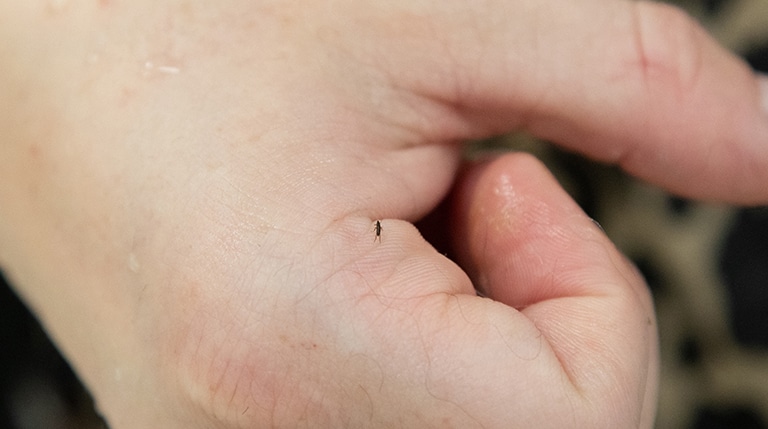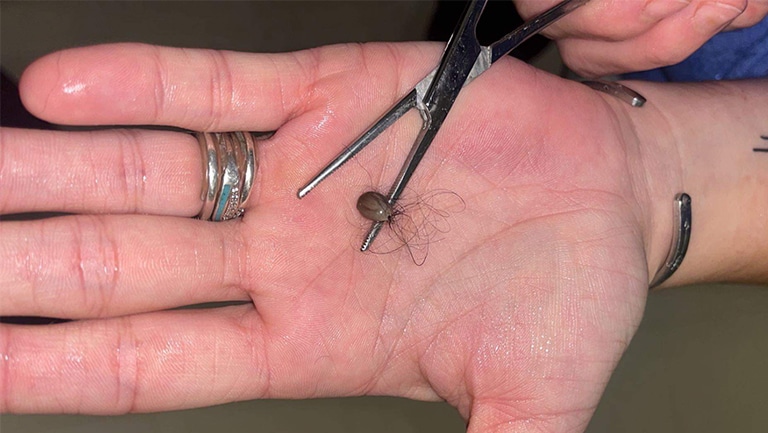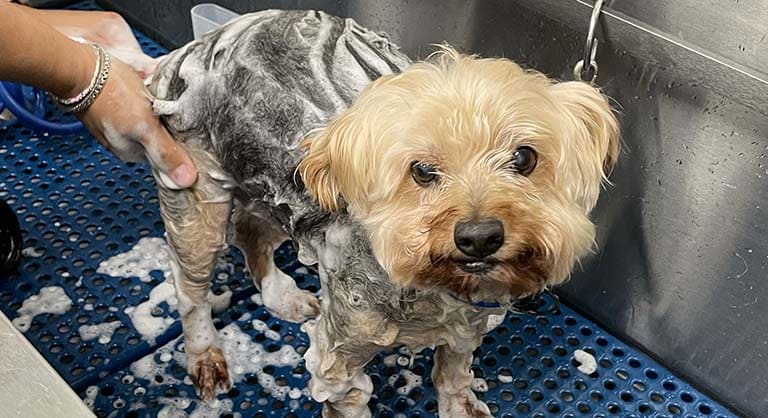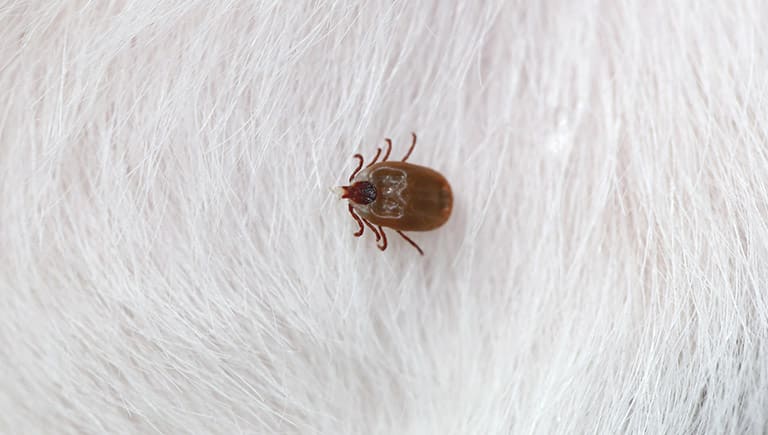Do dogs and cats only need flea and tick prevention during the warmer months? The answer to that question is no. Pets need year-round protection from these little critters. Though fleas and ticks may be less active during the colder months, there is still a risk of pest infestation for your pet and home.
Read this blog to learn how fleas and ticks survive the winter months, how to deter them from your yard and home even in cold weather, and how to protect your pets from fleas and ticks in winter.

How Fleas and Ticks Survive the Winter Months
Fleas
Fleas do not die immediately at the sign of cold weather. They can survive in temperatures as low as 46°F, and when temperatures reach below freezing it takes five consistent days of that extreme cold to kill off an adult flea – if they’re not already latched onto a warm body, that is.
The insect hops onto wild animals like raccoons, opossums and squirrels, as a mammal’s body heat and thick fur are ideal for fleas to ride out the frigid, cold weather. Also, the wild animals’ dens, burrows and nests provide a warm environment for the insect to thrive and continue their life cycle.

Ticks
Ticks like the Blacklegged tick (deer tick) can be active during warmer winter days when temps are 45°F or warmer. Adult deer ticks begin to look for food at the first signs of frost and attach themselves to deer they come across. These are the ticks that carry Lyme Disease. Blacklegged ticks reduce their activity when the temperatures drop below 35°F or there is snow on the ground. If not already latched onto a host, ticks will begin to die off once temperatures remain at a consistent 10°F.
Ticks with hard shells, like American dog ticks, hide among dead plants on the ground if they have not yet made a home on an animal’s warm body. Hiding among leaf litter (plant debris) is why ticks are commonly found in bushy, wooded areas. Soft-shell ticks like the common fowl tick go underground into burrows or dens. Both get insulated when there is snowfall. All ticks quickly recover when the temperatures get warmer.

How to Prevent Fleas and Ticks on Pets in Winter
Flea and tick prevention should continue all year round for pets. Owners can administer topical medication or have the animal wear their flea and tick collar during all the months of the year. A more natural approach includes essential oils like lemon grass, tea tree and rosemary. These essential oils can be diluted in a spray bottle, mixed with shampoo or put on a homemade flea and tick collar. Click here for more information on the types of flea and tick preventatives available.
How to Prevent Fleas and Ticks in Yards and Homes
Limit Their Ideal Outdoor Environment During the Fall
Fleas and ticks love to hide in dark and shady environments. These pests can migrate into yards, sheds and garages and easily come in contact with humans and pets. Keep the yard free of debris. As mentioned earlier, ticks hibernate in leaf litter and go underground. Ridding your yard of leaf piles, straw, clippings, twigs, sticks and wood piles helps to deter pests.
Maintain short grass in the yard. Fleas and ticks do not like sunlight; the more the ground is exposed to the sun, the less likely fleas and ticks make their way into the backyard. The CDC suggests creating a 3-foot barrier of gravel or wood chips between yards or patios and adjacent wooded areas, as ticks do not enjoy the trek over wood chips and gravel.

Deterring Fleas and Ticks from Sheds and Garages
Sheds provide excellent hiding spots for fleas and ticks in the winter months. If you have a shed, consider moving it to the sunniest part of the yard or purchasing one with enough windows to let in a significant amount of sunlight. It’s also a good idea to reduce the clutter in and around the outdoor storage building.
Sweep out your shed and move around the items inside occasionally to prevent hiding places where the fleas and ticks are not disturbed. Insulate the outdoor storage building and keep edible items like birdseed in airtight containers.
Garages also provide an ideal dark, warm environment for fleas and ticks. Place cups of cedar chips around the garage because fleas do not enjoy that scent. Rodents may be seeking a warm place to ride out the cold weather. Put mothballs and peppermint oil throughout the space as mice and rats do not enjoy those smells. Also, do not leave the garage door open for an extended period of time.

Pest Control
There are many products on the market for eliminating or preventing fleas and ticks from your yard or home. Call a pest control company to spray your lawn or home before the first frost. Make sure your pets do not come into contact with the pest control spray for at least a few hours – or preferably days (check the product label for recommendations). Pesticides can harm cats or dogs if ingested, heavily inhaled or absorbed through their skin.
Eradicating Fleas and Ticks from Your Home
Fleas and ticks enjoy making their home in carpets, rugs and bedding. Vacuuming is the best line of defense against these little pests. The machine picks up eggs, larvae and adults from different surfaces in the house. It’s also a good practice to wash your pet’s bedding consistently to prevent pest infestations. Use hot water and any type of pet shampoo.

Finding and Removing Fleas and Ticks from Your Pet
Removing Fleas and Ticks at Home
Check your pet for fleas by running your hand through their coat. Fleas will leave droppings that look like little specks of dirt on a pet’s skin. Using a flea comb, run it through your pet’s coat to remove the fleas. Your groomer can also give you suggestions for shampoos specially designed to kill fleas.
For ticks, do not use a flea comb. Instead, run your hands through your pet’s coat and search for any dark bumps. Make sure to check under their arms and in between their toes. When removing a tick, it’s important to ensure you remove the tick’s head and not just their body from your dog or cat’s skin.
For more detailed information on dealing with fleas and ticks, visit this blog.
Removing Fleas and Ticks at Your Pet Grooming Salon
When your pet is with a professional pet groomer, they will be examined and handled from head to toe. If fleas are found on your pet, our groomers will kill fleas on contact using safe, non-toxic flea shampoo. The groomer will also utilize a flea comb to assist in the flea removal treatment. This added service is required any time a pet is found to have fleas while in our care. If a tick is found by one of our groomers, they will carefully remove the tick. In most cases, there is no additional fee for tick removal.

Little, but Fierce
Though fleas and ticks are tiny, they can survive the harsh winter months and still latch onto your pets. They often travel by hitching a ride on other outdoor animals and commonly hide in brush, lawns, sheds and garages, making it easy to come into contact with pets who venture outdoors.
Pet owners can take precautions and initiate protection before their pet becomes vulnerable. Following the suggestions above, owners can deter fleas and ticks by altering their environment in various ways. It’s also recommended to continue providing pets with flea and tick protection, whether through collars or medications prescribed by a veterinarian or through a more holistic approach.
Bringing your pet in for routine grooming appointments helps to ensure your pet is free of fleas and ticks. When pet groomers find unwanted critters hiding inside a pet’s thick winter coat, they’ll use specialty products to eradicate them and provide relief for your pet.



